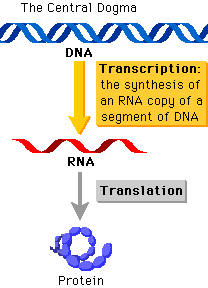The central dogma is the two-step process involving transcription and translation, by which gene information flows into proteins: DNA → RNA → protein. Proteins are encoded by individual genes used to orchestrate possibly every cell function. The central dogma shades light on the flow of genetic information in cells from DNA to proteins (mRNA). Furthermore, it states that genes are used to state the sequence of mRNA molecules used to specify the protein sequence in that order.

The main processes used by all cells to maintain their genetic information and convert the genetic information encoded in the DNA to form gene products, either RNAs or proteins depending on the gene, are:
- Replication– this is the basis of biological inheritance in living organisms. The process copies a cell’s DNA where the enzyme known as DNA polymerase copes a single parental double-stranded DNA molecule into two daughter double-stranded DNA molecules.
- Transcription-this process is used in the making of a complementary RNA copy a DNA sequence. RNA and DNA are nucleic acids that use the basic pairs of nucleotides as a language that enzymes can convert back and forth from DNA to RNA. The enzyme known as RNA polymerase forms an RNA molecule that is complementary to the gene-encoding stretch of the deoxyribonucleic acid (DNA).
- Translation– this is the process through which messenger RNA is decoded and translated to form a protein otherwise referred to as a polypeptide sequence. Using mRNA as a template, the ribosome creates a polypeptide chain of amino acids which folds to become a protein. The free amino acids are transferred from the cytoplasm to a ribosome by the transfer ribonucleic acid (tRNA). The amino acids are continuously added to the end of the growing polypeptide chain until they reach a stop codon on the mRNA. The ribosome thus releases the completed protein into the cell.

In eukaryotic organisms (organisms that have a nucleus), transcription and replication take place within the nucleus while translation takes place outside of the nucleus, in the cytoplasm. On the other hand, replication, translation, and transcription take place in the cytoplasm in prokaryotic organisms (organisms that do not have a nucleus).
Key Terms.
- Ribosome: mRNA or protein molecules that exist in all cells used in the production of proteins by translating mRNA.
- Codon: a series of three adjacent nucleotides that encode to create a specific amino acid during protein synthesis.
- Degenerate: this is the redundancy of the genetic code or simply when more than one codon codes for each amino acid.